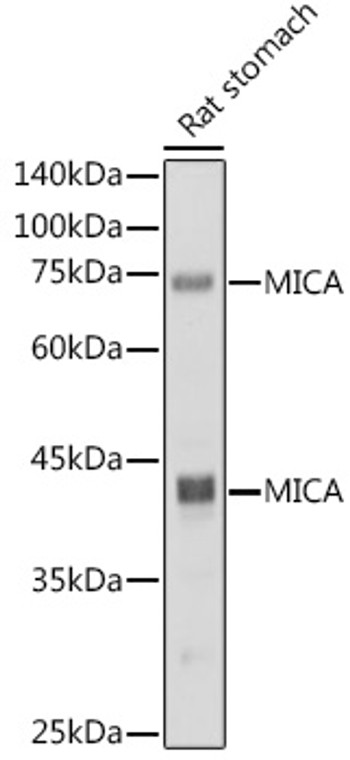| Host: |
Rabbit |
| Applications: |
WB |
| Reactivity: |
Human/Mouse/Rat |
| Note: |
STRICTLY FOR FURTHER SCIENTIFIC RESEARCH USE ONLY (RUO). MUST NOT TO BE USED IN DIAGNOSTIC OR THERAPEUTIC APPLICATIONS. |
| Short Description: |
Rabbit monoclonal antibody anti-MICA (50-150) is suitable for use in Western Blot research applications. |
| Clonality: |
Monoclonal |
| Clone ID: |
S8MR |
| Conjugation: |
Unconjugated |
| Isotype: |
IgG |
| Formulation: |
PBS with 0.02% Sodium Azide, 0.05% BSA, 50% Glycerol, pH7.3. |
| Purification: |
Affinity purification |
| Dilution Range: |
WB 1:500-1:1000 |
| Storage Instruction: |
Store at-20°C for up to 1 year from the date of receipt, and avoid repeat freeze-thaw cycles. |
| Gene Symbol: |
MICA |
| Gene ID: |
100507436 |
| Uniprot ID: |
MICA_HUMAN |
| Immunogen Region: |
50-150 |
| Immunogen: |
A synthetic peptide corresponding to a sequence within amino acids 50-150 of human MICA (Q29983). |
| Immunogen Sequence: |
HLDGQPFLRCDRQKCRAKPQ GQWAEDVLGNKTWDRETRDL TGNGKDLRMTLAHIKDQKEG LHSLQEIRVCEIHEDNSTRS SQHFYYDGELFLSQNLETKE W |
| Tissue Specificity | Widely expressed with the exception of the central nervous system where it is absent. Expressed predominantly in gastric epithelium and also in monocytes, keratinocytes, endothelial cells, fibroblasts and in the outer layer of Hassal's corpuscles within the medulla of normal thymus. In skin, expressed mainly in the keratin layers, basal cells, ducts and follicles. Also expressed in many, but not all, epithelial tumors of lung, breast, kidney, ovary, prostate and colon. In thyomas, overexpressed in cortical and medullar epithelial cells. Tumors expressing MICA display increased levels of gamma delta T-cells. |
| Post Translational Modifications | N-glycosylated. Glycosylation is not essential for interaction with KLRK1/NKG2D but enhances complex formation. Proteolytically cleaved and released from the cell surface of tumor cells which impairs KLRK1/NKG2D expression and T-cell activation. |
| Function | Seems to have no role in antigen presentation. Acts as a stress-induced self-antigen that is recognized by gamma delta T-cells. Ligand for the KLRK1/NKG2D receptor. Binding to KLRK1 leads to cell lysis. |
| Protein Name | Mhc Class I Polypeptide-Related Sequence AMic-A |
| Database Links | Reactome: R-HSA-198933 |
| Cellular Localisation | Cell MembraneSingle-Pass Type I Membrane ProteinCytoplasmExpressed On The Cell Surface In Gastric EpitheliumEndothelial Cells And Fibroblasts And In The Cytoplasm In Keratinocytes And MonocytesInfection With Human Adenovirus 5 Suppresses Cell Surface Expression Due To The Adenoviral E3-19k Protein Which Causes Retention In The Endoplasmic Reticulum |
| Alternative Antibody Names | Anti-Mhc Class I Polypeptide-Related Sequence A antibodyAnti-Mic-A antibodyAnti-MICA antibodyAnti-PERB11.1 antibody |
Information sourced from Uniprot.org
12 months for antibodies. 6 months for ELISA Kits. Please see website T&Cs for further guidance








